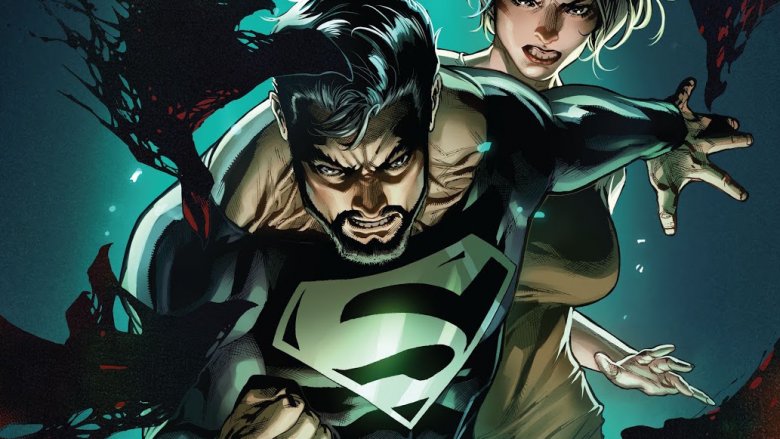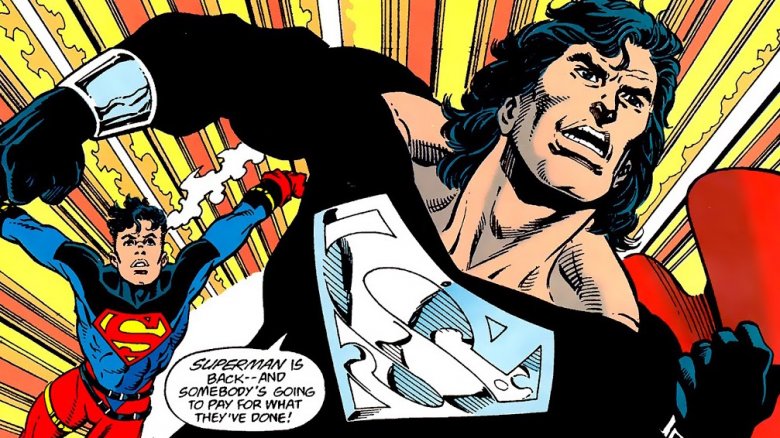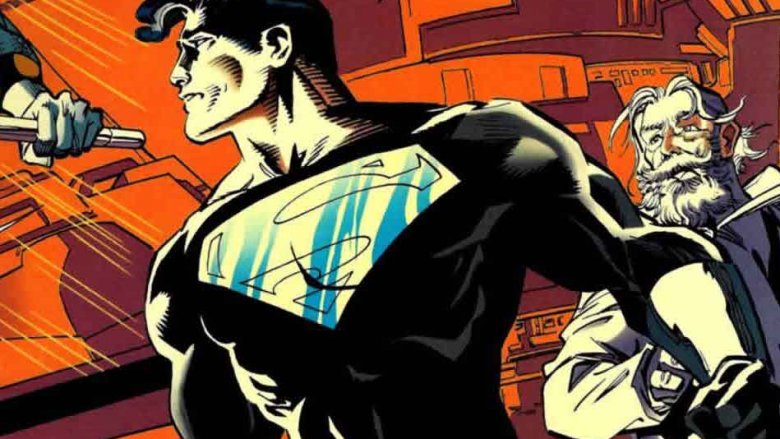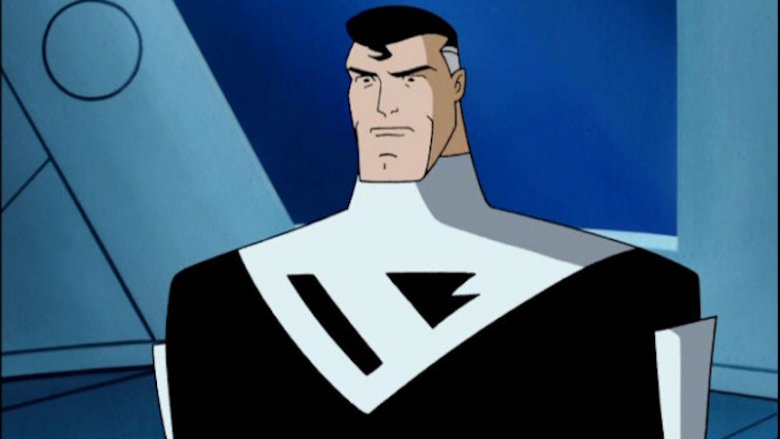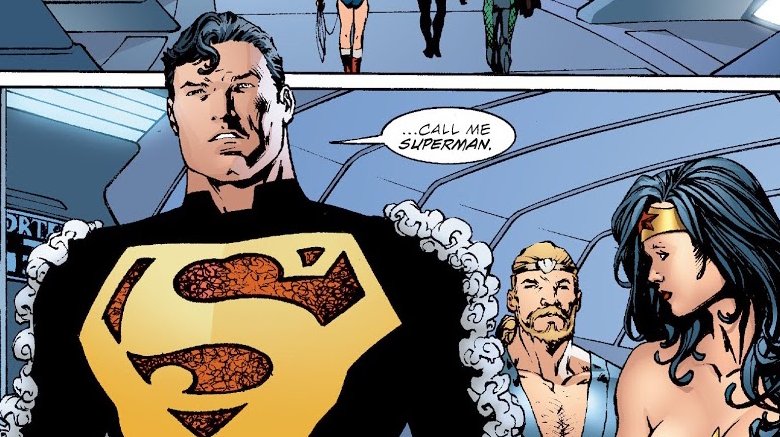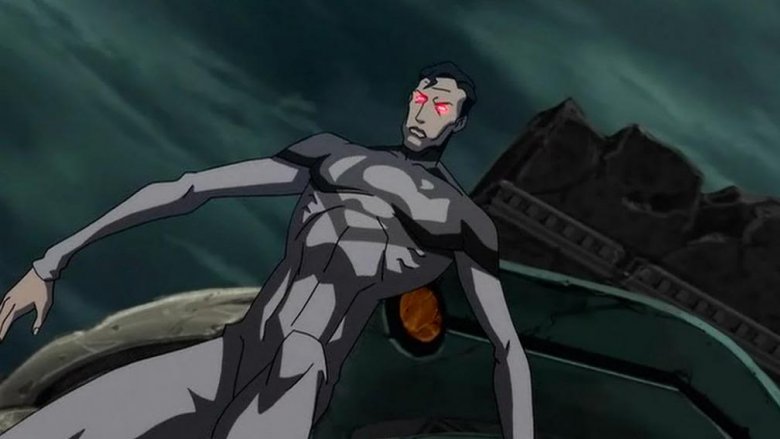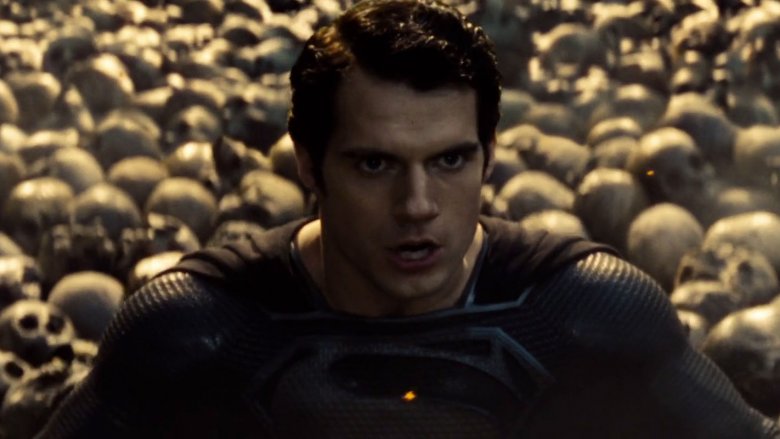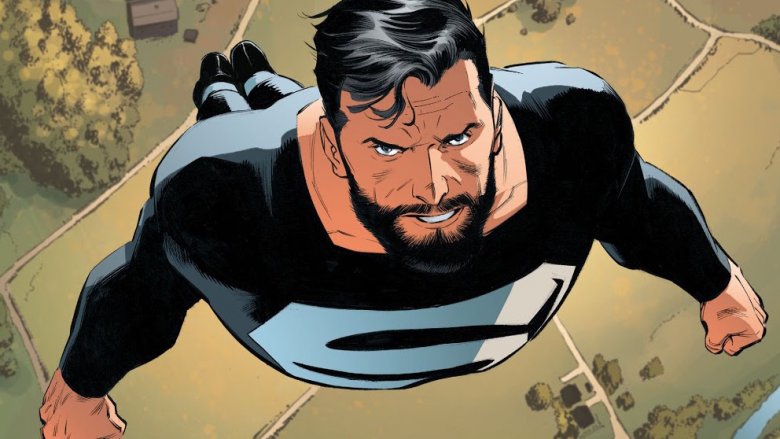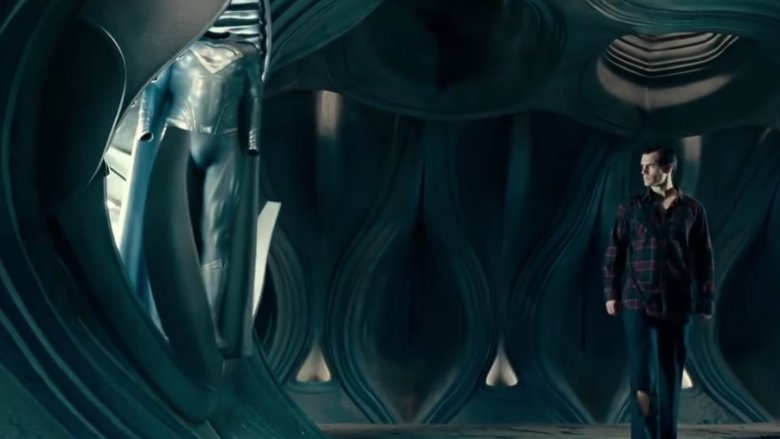What Superman's Black Costume Really Means
Superman's red and blue suit — in its various incarnations and designs — is as iconic as any other aspect of the character. Fans might argue about whether they prefer the New 52 design, or a more classic version that includes the infamous red underwear, but eventually Superman never flies too far away from the red-and-blue look; he always circles back.
That doesn't mean artists haven't given the Man of Steel radical new looks every now and then. Some worked better than others, and ever since the hero's death at the end of Batman v. Superman: Dawn of Justice, fans have been waiting for one of the more popular redesigns to arrive in live action. They're finally about to get it, but it won't be Henry Cavill sporting the darker duds.
The upcoming Arrowverse crossover "Elseworlds" features — among others — Tyler Hoechlin as Superman, and leaked set photos reveal Hoechlin in a much darker Superman uniform than most would be used to. DC Comics fans will recognize it as similar to a Superman costume usually associated with the character's resurrection in the comics after the 1992 Death of Superman event. The black suit and numerous variations have reappeared over the years, and looking at those appearances hints toward what we might expect from the black-clad Superman of "Elseworlds."
Back in Black
The Death of Superman was never really meant to be the death of Superman (evidenced by, among other things, the fact that Superman comics continued to be published while he was "dead") and the Reign of the Supermen event that followed fast on its heels would not only reveal what really happened to Kal-El, but it introduced the hero's black suit. Ironically, while it probably seems fitting for Superman to be clad in black right after his death, the practical purpose of the uniform was for just the opposite.
The black uniform was often referred to as the "regeneration suit" during Reign of the Supermen, and was designed to heal the hero. When Kal-El revived in a regeneration pod in the Fortress of Solitude, his powers were diminished. The regeneration suit was built to more aggressively absorb the radiation of a yellow sun in order to heal Superman and regenerate his godlike powers.
Shortly after Reign of the Supermen, Kal-El returned to the classic red and blue suit. But his resurrection wouldn't be the last time he needed the extra juice.
Here comes the sun
Five years after his death and resurrection, Kal-El would wear briefly wear the black suit again, starting with 1997's Action Comics #729.
The 1996 DC Comics line-wide event Final Night was kinder to Superman than Death of Superman in that it didn't kill Kal-El, but once again he found himself powerless. After numerous battles with the event's villain the Sun-Eater (who does exactly what the name suggests), Superman found himself needing to do things like drive cars and not get hit by bullets. With a little help from the New Gods and a brief return to the black regeneration suit he wore after his resurrection during Reign of the Supermen, Superman got super again.
Unfortunately, a few issues later the Man of Steel would enter the much-maligned Electric Superman era, and while sure, maybe they'll do that one in an Arrowverse crossover too, you shouldn't hold your breath.
Considering the black suit's origins, it could be a hint that the suit Tyler Hoechlin will be donning in "Elseworlds" is a signal that the crossover's Superman will be recovering from injuries, a recent de-powering, or even death.
Superman Beyond
The next time we saw Superman in an outfit similar to the regeneration suit was in November 2000 episodes of Batman Beyond, the animated series set in 2039 when Bruce Wayne passes the mantle of Batman onto the young Terry McGinnis.
The Beyond version of Superman first appeared in the two-part episode "The Call," in which Superman tries to recruit the new Batman to the Justice League, in part to help Superman find out if he's right about one of his teammates turning traitor. Superman's black uniform isn't identical to the regeneration suit — it's black and white rather than black and silver. The design itself is different, including a radically different logo.
The Beyond version of Superman has since appeared in the continuing comic book adventures, and the fact that his uniform somewhat resembles the regeneration suit has come to be much more fitting. We've learned that while you still wouldn't want to mess with him, this older Superman's powers are beginning to naturally wane.
Could this point towards the "Elseworlds" Superman being an older, weaker version? Maybe, but it doesn't seem likely. Tyler Hoechlin doesn't appear to have been made to look significantly older in the leaked set photos. He looks older than he did in Road to Perdition, sure, but puberty did that. Not makeup.
100% Superman
Superman briefly donned a black suit once more in the 2001 JLA storyline "Man and Superman" which took the psychological duality most superheroes experience (e.g. Superman/Clark Kent, Batman/Bruce Wayne) and made it a much more physical experience. The Justice League encountered aliens who used their powers to take away any of the heroes' inner conflicts. Superman and Clark Kent became two completely separate people with separate lives. The same happened with most of the other League members. Batman and Bruce Wayne became separate people; as did Green Lantern and Kyle Rayner, the Flash and Wally West, etc.
At first, rather than try to correct the situation, most of the super halves of the changed Leaguers threw themselves into their newfound freedom from the mundane and they signaled this shift in part with radical costume changes. Superman donned a new black outfit. While the logo was much different from that of the 1992 regeneration suit, the arms of the outfit were lined with strange bone-like structures that appeared identical to similar structures that were on his regeneration suit before he redesigned it. In JLA #53, Wonder Woman warned Superman that his new look was bothering people, but he brushed aside her concerns. It was never explicitly stated, but it seems likely this more "pure" and Clark-less Superman was wearing a suit that had the regeneration capacity of his older black suit and that he wore it to maximize his powers. Without his more human half to balance him, the notion of his new look having a negative impact on the populace likely seemed a trivial concern compared to the added power.
Flashpoint
When Barry Allen raced back in time to save his mother from being murdered, he inadvertently threw DC's continuity into the much darker Flashpoint reality. Among other startling changes, like Thomas Wayne replacing his son as a more lethal Batman, the Man of Steel was missing. When Superman was finally discovered to be a prisoner of the United States government, he appeared comparatively emaciated and underdeveloped.
Superman's outfit in the Flashpoint comics wasn't particularly reminiscent of his older regeneration suit, but when the event was adapted with 2013's animated movie Justice League: The Flashpoint Paradox, the hero's outfit seemed at least partly based on the black suit. It would make sense that, as little more than a government lab rat, Superman's handlers would give him clothing that was more practical than flashy. The darker color could mean it was being used to help with whatever experiments he was being subjected to by regulating how much sunlight his body could absorb at any given time.
Man of Steel
It was so brief that even if you noticed it might not have come off as intentional, but Superman's black suit kinda/sorta shows up in 2013's Man of Steel.
A nightmare sequence shows General Zod explaining his plan to terraform Earth into a new Krypton, wiping out humanity in the process. The scene ends with Superman appearing in a field of skulls and eventually descending into the bone as if it were quicksand. As he sinks, Superman's suit appears to grow darker. In a 2018 interview with Digital Spy, Michael Wilkinson — one of Man of Steel's costume designers — confirmed the nod to Superman's regeneration suit was intentional.
The choice is interesting considering the black suit was designed to heal Superman. So why, in a nightmare sequence, would it appear as Superman is surrounded by death? Was director Zack Snyder brushing aside the suit's practical application and simply going for the obvious association of death and the color black? Or, considering the scene was all taking place in Kal-El's mind, was the appearance of the black suit an unconscious call for help?
Brutaal
The color black is often associated with evil, so it's surprising that with so many variations of Superman's black outfit that almost none of them are meant to signal a "bad guy" Superman – almost none of them.
In 2013's Earth 2 #14, a new Kryptonian character was introduced working alongside the armies of Darkseid. The villain was eventually revealed to be Brutaal — a clone of Superman created by Darkseid, donning a black-and-red version of his originator's iconic outfit.
Brutaal is a reminder that the appearance of a black-clad Superman in the Arrowverse could mean Tyler Hoechlin's outfit has nothing to do with absorbing the sun's rays; it could just mean he's a bad guy. Considering the name of the crossover is "Elseworlds," the fact that alternate versions of Flash and Green Arrow will appear, and the fact that Arrowverse characters tend to travel to alternate Earths as easily as you or I can grab an Uber, it's conceivable the black-clad Superman of "Elseworlds" will be from an alternate Earth and that he won't be the icon of justice with which we're familiar.
Lois & Clark
In the 2015 event Convergence, the pre-Flashpoint Superman and Lois Lane were brought into the world of the New 52. The New 52 version of Superman would eventually die and the older version would take his place, but before that happened, the pre-Flashpoint Superman did his best to help the world in relative secrecy in 2015's Superman: Lois & Clark.
To distinguish himself from the New 52 Superman and to attract less attention, the older Superman wore a suit clearly based on his old black-and-silver regeneration suit. Once Rebirth came and he replaced his younger self, Kal-El returned to a red and blue outfit.
This is a reminder that the Arrowverse black-clad Superman might not be an alternate version of the character. When a darker version of Superman's outfit is spotted in the Fortress of Solitude in season 2 of Supergirl, Superman explains he wore it during a time when he wanted to act with more secrecy. Assuming the "Elseworlds" crossover is taking place on alternate Earths, it's possible the Arrowverse Superman we already know is wearing the black suit and that he's doing it specifically to minimize the attention he gets. Maybe he doesn't want to step on any alternate Superman toes, or maybe he fears the impact his public presence could have on other Earths.
Justice League
Fans wanted to finally get Henry Cavill in a black outfit once he was resurrected in 2017's Justice League, and they wanted more than the blink-and-you'll-miss-it moment they got in Man of Steel. According to Michael Wilkinson, Justice League's costume designer, those fans almost got their wish.
"The black suit is something that has fascinated us as filmmakers from the get-go," Wilkinson told Digital Spy in 2018. "When we were prepping Justice League, at first it seemed that it might be a logical choice for the look of Superman when he's resurrected."
For better or worse, it seems likely that the criticisms of the DCEU films being too dark — and Warners' commitment to turn away from that grittiness — was what threw the black suit in the shredder.
"[A]s the tone of the film developed and we were in pre-production," Wilkinson said, "the filmmakers felt that the classic red and blue suit seemed more appropriate to our story and our script. It seemed that a more positive, upbeat image of Superman was what was needed."
Though fans still didn't get to see Cavill in the regeneration suit, a Justice League deleted scene features the black suit as an Easter egg. The suit reveals itself to Kal-El as he walks through a Kryptonian ship (kind of like when you walk down the freezer aisle and the motion sensors turn the lights on so you can see all the Hot Pockets).
